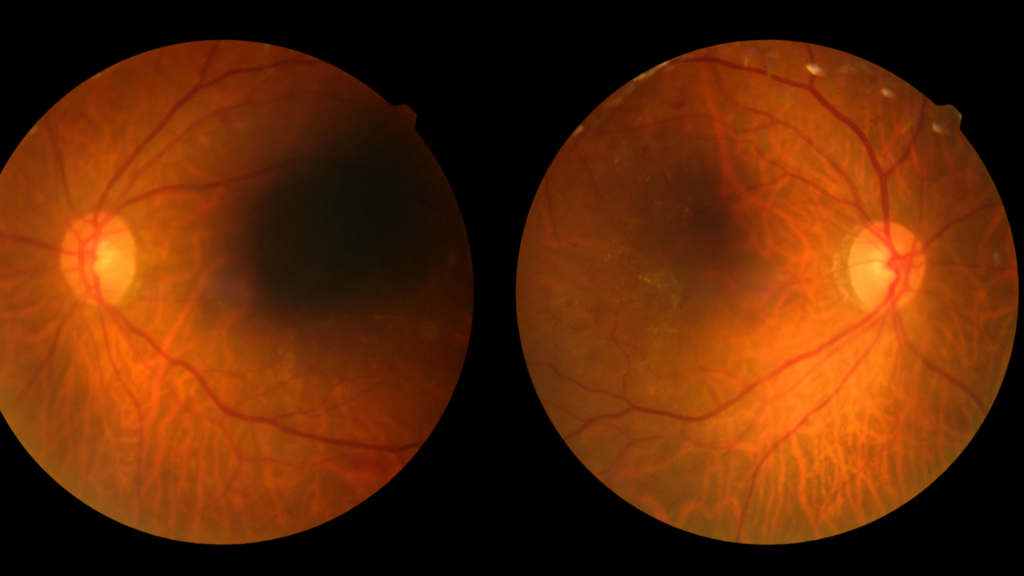November is Diabetic Retinopathy Awareness Month, a time to shed light on a condition that remains a significant cause of blindness among adults. Affecting millions of people with Type 1 and Type 2 diabetes, diabetic retinopathy develops when high blood sugar levels damage the blood vessels in the retina.
At WashU Medicine, researchers are leading the way in understanding and addressing the mechanisms behind diabetic retinopathy, offering new hope for prevention and treatment.

What Is Diabetic Retinopathy?
Diabetic retinopathy occurs when prolonged high blood sugar damages the tiny blood vessels in the retina, leading to vision problems. It progresses through four classically-described stages:
- Mild non-proliferative retinopathy
- Moderate non-proliferative retinopathy
- Severe non-proliferative retinopathy
- Proliferative diabetic retinopathy (PDR), the most advanced stage, which can result in blindness.
Increasingly, physicians are becoming aware of neural damage to the retina that may occur in parallel with the classical vascular problems. Together, the neural and vascular changes are termed Diabetic Retinal Disease.
Without early detection and treatment, diabetic retinopathy can lead to irreversible vision loss. This is why ongoing research, early screenings, and innovative treatments are essential to combat this growing public health concern.
A Growing Epidemic

Rithwick Rajagopal, MD, PhD
Associate Professor, Ophthalmology and Visual Sciences
- Email: rajagopalr@nospam.wustl.edu
- Retina
- Rajagopal Lab page
According to Rithwick Rajagopal, MD, PhD, a leader in diabetic retinopathy research at WashU Medicine:
“Diabetic retinopathy is the fifth most common cause of blindness worldwide, but whereas blindness from all other causes has been steadily decreasing over the past 30 years, blindness from diabetic retinopathy has greatly increased during the same time. Such worrisome epidemiological data highlight a pressing need for better screening, prevention, and treatment strategies for diabetic retinopathy.”
Rithwick Rajagopal, MD, PhD
This alarming trend underscores the urgency of WashU Medicine’s work, which spans groundbreaking advances in screening, detection, and treatment development.
Innovative Research in Diabetic Retinal Disease
Dr. Rajagopal’s lab has been at the forefront of pioneering studies on diabetic retinal disease. Key highlights of their work include:
- AI-Based Screening: The lab was an early adopter of artificial intelligence (AI) in detecting diabetic retinopathy. Their research demonstrated that point-of-care AI screening significantly improves follow-up adherence in patients, ensuring they receive timely care.
- Electroretinography (ERG): Experimental models validated ERG as a tool for detecting diabetic retinal disease before vascular lesions develop, offering the potential for earlier intervention.
- Photoreceptor Metabolism Studies: The team uncovered how elevated glucose causes abnormal metabolism in photoreceptors, which then subsequently leads to the development of vascular lesions in diabetic retinopathy. Correcting these metabolic abnormalities in preclinical models reduced disease severity, paving the way for targeted therapies. PMID: 39328824, PMID: 37741454, PMID: 34425110
- Dietary Interventions: Investigations into time-restricted eating and ketogenic diets show promise in reducing the burden of diabetic retinopathy, offering potential non-invasive preventive strategies.
- Impact of Novel Diabetes Medicine on Retinopathy: Drugs such as semaglutide (Ozempic) and tirzepatide (Mounjaro) have led to miraculous results in diabetes control but have also raised some concerns about a potential increase in the risk of blindness from diabetic retinopathy. The lab reviewed data on these topics and offer guides to therapy for both ophthalmologists and diabetes doctors.
- Fenofibrate Research: As part of a nationwide Phase 3 clinical trial, Dr. Rajagopal’s team is studying the lipid-lowering drug fenofibrate, which may significantly reduce diabetic retinopathy progression risk in Type 1 and Type 2 diabetes. Independently, the lab is also investigating the molecular mechanisms of this drug in the retina, which currently remain unknown.
A Look to the Future
Research at WashU Medicine continues to push boundaries, with a focus on developing curative therapies and preventive measures. Dr. Rajagopal emphasizes:
“New tools to correct abnormal photoreceptor metabolic signatures in diabetes could be curative for blinding disease. Our lab is deeply involved in this transformative research.”
Rithwick Rajagopal, MD, PhD
The Role of Awareness and Screening
Diabetic retinopathy often progresses silently until it causes significant vision problems. Regular eye screenings are crucial for early detection and intervention. AI-powered technologies and tools like ERG are improving the accuracy and accessibility of these screenings, helping to combat the growing diabetic retinopathy epidemic.
Join the Fight Against Diabetic Retinopathy
This November, WashU Medicine encourages everyone to take part in Diabetic Retinopathy Awareness Month. Whether it’s scheduling a screening, supporting ongoing research, or sharing knowledge with loved ones, your contribution can make a difference.
Stay updated on our latest research and advancements. Together, we can work toward a future free of blindness caused by diabetic retinopathy.